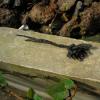
11-02-2012 12:21
 AndrÃĐ COUDER
AndrÃĐ COUDER
BonjourSur UlexJe n'ai pas de description dans mes

10-02-2012 20:30
 Alex Akulov
Alex Akulov
Dear FriendsI am trying to identify the anamorphic

10-02-2012 21:44
Hi all.I have a collection of Hymenoscyphus phasco

07-02-2012 16:26
25.06.11. Pycn. immergÃĐes, en colonies, sur branc

09-02-2012 17:17
Bonjour à tous,Quelques petites rÃĐcoltes faites

08-02-2012 18:25
Bonjour à tous,Cela fair plusieurs fois que je ne
Xylaria
Peter Welt,
07-05-2010 18:35
 Does a Xylaria this? Found in an orchid house at Robinia. Spores 12 x 5 Âĩm. More here:
Does a Xylaria this? Found in an orchid house at Robinia. Spores 12 x 5 Âĩm. More here:http://www.pilzepilze.de/cgi-bin/webbbs/pconfig.pl?noframes;read=182151
Peter
Alain GARDIENNET,
07-05-2010 23:18
Re:Xylaria
Bonsoir Peter,
I think it's probably a Xylaria. In France, Jacques Fournier is the specialist of this family. He will come back next week at home and therefore on Ascofrance.
Personally, I don't know Xylaria arbuscula but perhaps your recolt refers to it ? And I don't know if it could be an european species.
Let's wait...
It's a nice recolt.
Alain
I think it's probably a Xylaria. In France, Jacques Fournier is the specialist of this family. He will come back next week at home and therefore on Ascofrance.
Personally, I don't know Xylaria arbuscula but perhaps your recolt refers to it ? And I don't know if it could be an european species.
Let's wait...
It's a nice recolt.
Alain
Jacques Fournier,
10-05-2010 17:13

Re:Xylaria
Hi Peter,
I think Alain's guess is good. I saw several similar specimens from a greenhouse of Postdam botanical garden. See the attached description based on these collections. As the original material of X. arbuscula was collected in such a greenhouse it can be assumed they are all conspecific, but the boundaries with similar tropical material are still unsettled.
This problem is partly dealt with in a coming paper on three new Xylaria species to be published in Mycological Progress, already available online to people who have access to this journal.
Best wishes,
Jacques
I think Alain's guess is good. I saw several similar specimens from a greenhouse of Postdam botanical garden. See the attached description based on these collections. As the original material of X. arbuscula was collected in such a greenhouse it can be assumed they are all conspecific, but the boundaries with similar tropical material are still unsettled.
This problem is partly dealt with in a coming paper on three new Xylaria species to be published in Mycological Progress, already available online to people who have access to this journal.
Best wishes,
Jacques
Peter Welt,
10-05-2010 17:49

Re:Xylaria
Merci Jacques
Should we send you something from the Xylaria?
Should we send you something from the Xylaria?
FELIPE SAN MARTÃN,
12-02-2012 17:22
Re : Xylaria
Amend: "... likes to fruit in greenhouses".

 11388.doc
11388.doc